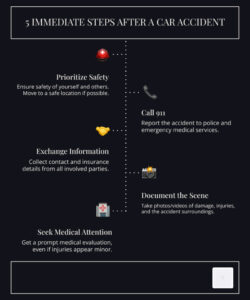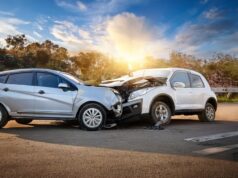First Response: Critical Steps to Take Immediately After a Collision

Being involved in a car accident can be a frightening and confusing experience. One moment, you’re driving, and the next, your world is unexpectedly disrupted. Beyond the immediate shock, accidents bring a whirlwind of worries about the legal process, financial recovery, and managing stress.
We understand these challenges. This guide is here to help you steer the aftermath of an auto collision. We will walk you through the essential first steps to take, explain how the legal system works, and clarify your options for financial recovery.
Our goal is to provide clear, actionable advice. We aim to empower you during what can be a very difficult time.
The moments immediately following a car accident are often chaotic, but your actions during this critical period can significantly impact your safety, health, and any potential legal claims. Prioritizing safety and acting systematically are key.
What are the immediate steps to take after a car accident in Ontario?
While specific laws can vary by jurisdiction, the foundational immediate steps after a car accident are largely universal, including in Ontario.
- Prioritize Safety and Assess Injuries: Your immediate priority should be the safety of yourself and any passengers. Check for injuries. If anyone is seriously hurt, do not move them unless they are in immediate danger (e.g., from fire or oncoming traffic).
- Move to a Safe Location (If Possible): If your vehicle is operational and it’s safe to do so, move it to the side of the road or a nearby safe area to prevent further accidents. If not, turn on your hazard lights.
- Call 911 (Emergency Services): Even if injuries seem minor, it’s crucial to call 911. This ensures that emergency medical services can attend to any injured parties and that law enforcement can respond to create an official police report. In Ontario, police must be called if there are injuries, fatalities, or property damage exceeding a certain threshold (e.g., $2,000 in combined damage).
- Exchange Information: With the other driver(s) involved, exchange essential contact and insurance information.
- Document the Scene: Take photos and videos of the accident scene, vehicle damage, and any visible injuries.
- Seek Medical Attention: Even if you feel fine, adrenaline can mask pain. It’s vital to seek a medical evaluation as soon as possible.
- Do Not Admit Fault: While it’s natural to apologize or express concern, avoid making statements that could be interpreted as admitting fault. Stick to the facts.
On an average day, approximately 325 Canadians sustain injuries from motor vehicle accidents, and about one in 10 of these victims will be admitted to the hospital or die from their injuries. These statistics underscore the importance of taking every accident seriously and following these steps diligently.

What to Document at the Scene
Detailed documentation from the accident scene is invaluable. It serves as objective evidence that can support your insurance claim and any future legal proceedings.
Here’s a list of essential information to collect:
- Other Driver’s Information:Full name and contact information (phone number, address)
- Driver’s license number
- License plate number
- Insurance company name and policy number
- Vehicle make, model, and year
- Witness Information:Names and contact details of any eyewitnesses. Their unbiased accounts can be crucial.
- Photographs and Videos:Capture damage to all vehicles involved from multiple angles.
- Photograph the overall accident scene, including road conditions, traffic signs, skid marks, and any debris.
- Take pictures of any visible injuries you or your passengers sustained.
- Document the weather conditions and time of day.
- Police Report Details:The responding officer’s name and badge number.
- The police report number, if available at the scene.
- Your Own Notes:Write down a detailed account of how the accident happened from your perspective as soon as possible, while memories are fresh. Include the date, time, and location.

The Importance of a Prompt Medical Evaluation
One of the most critical steps after an accident, even if you feel fine, is to seek immediate medical attention. Adrenaline can mask pain and the severity of injuries, leading to delayed symptoms for conditions like whiplash, concussions, or internal injuries.
A prompt medical evaluation serves several vital purposes:
- Health and Well-being: It ensures that any injuries, visible or hidden, are diagnosed and treated early, preventing them from worsening.
- Establishing a Medical Record: This creates an official record linking your injuries directly to the accident. This documentation is crucial for any insurance claims or legal actions, as it demonstrates causation.
- Following Doctor’s Orders: Adhering to your doctor’s prescribed treatment plan is not only essential for your recovery but also strengthens your claim by showing diligence in seeking care.
Ignoring injuries or delaying treatment can complicate your recovery and make it harder to prove that your injuries resulted directly from the accident.
Navigating the Claims Process: Understanding Your Rights and Options
Once the immediate aftermath is handled, the next phase involves navigating the complex world of insurance claims and legal options. Understanding the different types of claims and how they work is crucial for securing the compensation you deserve.
Types of Compensation You Can Claim
After a car accident, victims can typically claim various types of compensation, often categorized as economic and non-economic damages.
Economic Damages (Quantifiable Losses):
- Medical Bills: This includes emergency room visits, doctor consultations, surgeries, medications, physical therapy, and other related medical expenses.
- Rehabilitation Costs: Long-term care, specialized therapies, and adaptive equipment needed for recovery.
- Lost Wages: Income lost due to time off work for recovery or medical appointments.
- Future Income Loss: Compensation for diminished earning capacity if your injuries prevent you from returning to your previous job or working at the same level.
- Property Damage: Costs to repair or replace your vehicle and any other damaged personal property.
Non-Economic Damages (Non-Quantifiable Losses):
- Pain and Suffering: Compensation for physical pain and emotional distress caused by the injuries.
- Emotional Distress: This can include anxiety, depression, PTSD, or other psychological impacts resulting from the accident.
- Loss of Enjoyment of Life: Compensation for the inability to participate in hobbies, activities, or daily routines you enjoyed before the accident.
The specific types and amounts of compensation can vary significantly based on the severity of your injuries, the impact on your life, and the laws of your jurisdiction.
What is the difference between accident benefits (no-fault) and tort claims?
In many jurisdictions, including Ontario and some U.S. states like Florida, car accident claims operate under a dual system involving both “no-fault” benefits and “tort” claims. Understanding the distinction is fundamental to pursuing appropriate compensation.
Accident Benefits (No-Fault):
- Definition: These benefits are available to anyone injured in a car accident, regardless of who was at fault. They are typically claimed through your own insurance policy (or the policy of the vehicle you were in).
- Purpose: To provide immediate financial relief for essential expenses.
- Coverage: Often includes medical and rehabilitation expenses, income replacement benefits (for lost wages), attendant care, and in some cases, housekeeping and caregiver benefits. In Ontario, these are known as Statutory Accident Benefits (SABS).
- Process: You apply for these benefits directly with your insurer. Disputes are often resolved through internal processes or mediation.
Tort Claims:
- Definition: These are claims made against the at-fault driver (and their insurance company) to seek compensation for damages not covered by no-fault benefits, or for losses exceeding those limits.
- Purpose: To compensate the injured party for losses caused by another’s negligence, aiming to put them back in the position they would have been in had the accident not occurred.
- Coverage: Can include pain and suffering, future income loss, future medical expenses, and other pecuniary and non-pecuniary damages.
- Process: This typically involves a lawsuit filed by the injured party against the at-fault driver. Proving fault is central to a tort claim.
Here’s a table comparing the two:
Feature Accident Benefits (No-Fault) Tort Claims Fault Not required; available regardless of who caused the accident Required; made against the party responsible for the accident Source Your own insurance policy (or the vehicle you were in) The at-fault driver’s insurance policy Types of Losses Medical/rehab, income replacement, attendant care, etc. Pain and suffering, future lost income, future medical, property damage Process Application to insurer, often administrative/mediation Lawsuit against at-fault party, requires proving negligence Goal Immediate support for essential needs Comprehensive compensation for all damages caused by negligence How do insurance companies handle car accident claims, and what tactics should victims be aware of?
Insurance companies are businesses, and their primary goal is to minimize payouts. While they have a duty to act in good faith, they often employ tactics that can disadvantage accident victims.
Common Insurance Company Tactics:
- Quick Settlement Offers: Insurers may offer a low settlement early on, hoping you’ll accept before fully understanding the extent of your injuries or the true value of your claim. This is especially common when victims are still recovering and facing financial pressure.
- Requesting Recorded Statements: They might ask for a recorded statement, which can later be used against you if your memory or description of events changes slightly, or if you inadvertently say something that undermines your claim.
- Downplaying Injuries: Insurers may argue that your injuries are not severe, pre-existing, or not directly caused by the accident. They might question the necessity of your medical treatments.
- Delay Tactics: Prolonging the claims process can wear down victims, making them more likely to accept a lower offer out of frustration or financial necessity.
- Accessing Your Medical History: They may request broad access to your entire medical history, looking for anything that could suggest a pre-existing condition or an alternative cause for your current injuries.
- Monitoring Social Media: Insurers often monitor claimants’ social media activity for posts or photos that contradict their reported injuries or limitations.
- Attributing Fault: They might try to shift some or all of the blame for the accident onto you, which can reduce the amount of compensation they have to pay.
What Victims Should Be Aware Of:
- Don’t Rush to Settle: Never accept a settlement offer until you have completed medical treatment and understand the full extent of your damages, including future medical needs and lost earning capacity.
- Be Cautious with Statements: It’s generally advisable to consult with a lawyer before giving any recorded statements to the at-fault driver’s insurance company.
- Limit Information Sharing: Provide only necessary information. Do not speculate or offer details beyond the facts.
- Keep Detailed Records: Maintain meticulous records of all medical treatments, expenses, communications with insurance companies, and any impact the accident has had on your daily life.
- Consult a Lawyer: An experienced personal injury lawyer can act as your advocate, handle all communications with insurers, and protect you from these tactics.
What happens if the at-fault driver is uninsured or unidentified?
Being involved in an accident with an uninsured or unidentified driver can add significant stress, but it doesn’t necessarily mean you’re out of options for compensation.
Uninsured Motorist (UM) Coverage:
- Your Own Policy: If you have Uninsured Motorist (UM) coverage as part of your own auto insurance policy, this coverage will step in to pay for your medical expenses, lost wages, and pain and suffering, up to your policy limits, as if the uninsured driver’s insurance was paying.
- Importance: This coverage is crucial and highly recommended, as it protects you in situations where the at-fault driver lacks insurance or has insufficient coverage.
Unidentified Driver (Hit-and-Run):
- Your Own Policy: In hit-and-run scenarios, your UM coverage typically also applies, treating the unidentified driver as an uninsured one.
- Motor Vehicle Accident Claims Fund (Ontario Example): In Ontario, if you are a pedestrian victim in a hit-and-run, or if there are no other auto insurance policies that can respond, the Motor Vehicle Accident Claims Fund (MVAC Fund) acts as a “payor of last resort.” This fund provides compensation for accident benefits and tort claims when no other insurance is available (e.g., for uninsured, unidentified drivers, or stolen vehicles).
It’s essential to report hit-and-run accidents to the police immediately, as this is often a requirement for your insurance company to honor your UM claim. Prompt legal advice is critical in these complex situations to ensure you understand your rights and how to access available coverage.
What Happens if You Are At-Fault?
Even if you are determined to be at-fault for a car accident, you still have rights and responsibilities.
- No-Fault Benefits Access: In jurisdictions with no-fault insurance (like Ontario and Florida for PIP), you are generally still entitled to accident benefits from your own insurance policy, regardless of fault. These benefits cover immediate medical expenses, rehabilitation, and potentially lost income.
- Liability for Other’s Damages: Your liability insurance will typically cover the damages and injuries sustained by the other parties involved in the accident, up to your policy limits. This protects you from having to pay out-of-pocket for their losses.
- Insurance Coverage Limits: It’s crucial to understand your policy’s liability limits. If the other parties’ damages exceed your coverage, you could potentially be personally responsible for the difference.
- Potential for Being Sued: If the other parties’ injuries are severe or their losses exceed your insurance coverage, they may file a tort claim against you personally.
- Increased Premiums: Being at-fault for an accident will almost certainly lead to an increase in your insurance premiums.
Even if you believe you are at fault, it’s wise to consult with a legal professional. They can help you understand your obligations, ensure your rights are protected, and steer communications with your insurer and any other involved parties.
The Role of Evidence and Deadlines in Your Case
Building a strong car accident claim hinges on compelling evidence and adherence to strict legal deadlines. These two elements are foundational to securing fair compensation.
Why Medical Records are the Foundation of Your Injury Claim
Medical records are not just about your health; they are the backbone of any personal injury claim. They provide objective proof of your injuries, documenting the extent of the harm, the course of treatment, and the prognosis for recovery.
- Objective Proof of Injury: Unlike subjective statements, medical records from doctors, specialists, and therapists offer unbiased evidence of your condition.
- Documenting Treatment: They detail every visit, diagnosis, procedure, medication, and therapy, creating a clear timeline of your recovery journey. This helps establish the necessity and reasonableness of medical expenses.
- Demonstrating Severity: Records can illustrate the severity of your injuries, how they impact your daily life, and any limitations they impose. This is crucial for claiming pain and suffering and loss of enjoyment of life.
- Supporting Future Care Needs: If your injuries require ongoing treatment or care, medical records and expert opinions can project future medical expenses, which are a significant component of compensation.
- Expert Medical Opinions: Your medical records form the basis for expert medical opinions regarding causation (linking injuries directly to the accident) and the long-term impact of your injuries.
Without comprehensive and consistent medical documentation, it becomes significantly harder to prove the extent of your injuries and their direct link to the car accident, potentially jeopardizing your claim.
Understanding the Statute of Limitations
The “statute of limitations” is a critical legal deadline that dictates how long you have to file a lawsuit after an injury. Missing this deadline almost always means forfeiting your right to pursue compensation, regardless of the merits of your case.
- Filing a Lawsuit: This refers to the specific timeframe within which you must formally initiate legal action in court.
- Time Limits: These limits vary significantly by jurisdiction and the type of claim. For instance, in Ontario, if you have been injured in a car accident, you only have two years from the date of the accident to pursue a lawsuit against the at-fault party. Many U.S. states have similar two-year limits for personal injury claims, though some are longer or shorter.
- Critical Deadline: The statute of limitations is an absolute deadline. Once it passes, your claim is legally barred.
- Preserving Your Legal Rights: Being aware of and adhering to this deadline is paramount to preserving your legal rights.
- Exceptions to the Rule: While strict, there can be exceptions, such as for minors (the clock might not start until they turn 18) or in cases where an injury isn’t finded until much later (the “findy rule”). However, relying on exceptions is risky and requires expert legal guidance.
Given the strict nature of these deadlines, it is always advisable to consult with a personal injury lawyer as soon as possible after an accident. They can accurately determine the applicable statute of limitations for your specific case and ensure all necessary legal steps are taken in a timely manner.
When to Seek Professional Car Accident Legal Advice
While some minor fender-benders might be handled directly with insurance companies, many car accident scenarios warrant professional legal advice. The complexities of insurance claims, the nuances of personal injury law, and the tactics employed by insurance companies often necessitate the expertise of a lawyer.
How a Lawyer Provides Car Accident Legal Advice and Support
A personal injury lawyer acts as your advocate, handling the intricate legal and administrative aspects of your claim so you can focus on your recovery.
- Investigation and Evidence Gathering: Lawyers will thoroughly investigate the accident, collecting all necessary evidence such as police reports, witness statements, traffic camera footage, and accident reconstruction reports. They ensure all documentation, including your medical records, is properly organized and presented.
- Negotiation with Insurers: They handle all communications and negotiations with insurance companies, protecting you from tactics designed to minimize your payout. They understand how to counter low settlement offers and advocate for fair compensation.
- Calculating Full Damages: A lawyer can accurately assess the full extent of your damages, including not only current medical bills and lost wages but also future medical expenses, lost earning capacity, pain and suffering, and other non-economic losses.
- Filing a Lawsuit: If a fair settlement cannot be reached through negotiation, your lawyer will prepare and file a personal injury lawsuit on your behalf, guiding you through the litigation process.
- Expert Guidance: They provide clear, understandable car accident legal advice, explaining your rights, options, and the likely outcomes at each stage. For those seeking comprehensive guidance, especially in areas like Clearwater, seeking Clearwater car accident legal advice can ensure local expertise is applied to your case.

Specific Challenges That Require Car Accident Legal Advice
Certain types of motor vehicle accidents present unique challenges that almost always require specialized legal expertise.
- Truck Accidents: Accidents involving large commercial trucks are often catastrophic due to their immense size and weight. These cases are complex, involving federal regulations, multiple potentially liable parties (driver, trucking company, cargo loader, maintenance crew), and specialized insurance policies.
- Motorcycle Accidents: Motorcyclists are incredibly vulnerable on the road, and accidents often result in severe injuries. There can also be a societal bias against riders, making it challenging to prove fault and overcome perceptions. A lawyer can combat this bias and ensure the rider’s rights are protected.
- Pedestrian Accidents: Pedestrians are among the most vulnerable road users. When struck by a vehicle, injuries are typically severe. Proving fault can be complicated, especially if the pedestrian is accused of jaywalking or not using a crosswalk.
- Multi-Vehicle Pile-ups: Accidents involving three or more vehicles create a tangled web of liability. Determining who is at fault for which impact, and how insurance policies interact, requires sophisticated legal analysis.
- Drunk Driving Accidents: While the at-fault driver may face criminal charges, a personal injury lawyer can pursue a civil claim to ensure the victim receives compensation for their injuries and losses. They can also explore punitive damages in cases of gross negligence.
- Distracted Driving Accidents: With distracted driving now responsible for more deaths on Ontario’s roads than drunk driving, these cases are becoming increasingly common. Proving distracted driving can be challenging, often requiring access to phone records or witness testimony.
In these and other complex scenarios, a lawyer’s experience in navigating specific regulations, overcoming biases, and managing intricate liability issues is invaluable.
Frequently Asked Questions about Auto Accident Claims
It’s natural to have many questions after an auto accident. Here, we address some of the most common inquiries.
What if I was partially at fault for the accident?
Many jurisdictions operate under a legal principle called “comparative negligence” or “contributory negligence.” This means that even if you were partially at fault for an accident, you might still be able to recover compensation.
- Comparative Negligence: In states with comparative negligence laws (like Florida), your compensation may be reduced by your percentage of fault. For example, if you are found to be 20% at fault for an accident that caused $100,000 in damages, you would only be able to recover $80,000.
- Contributory Negligence: A few states still follow “contributory negligence” rules, which are much stricter. If you are found to be even 1% at fault, you may be barred from recovering any compensation at all.
- Shared Fault Rules: Determining shared fault can be complex and is often a point of contention between insurance companies. An experienced lawyer can argue on your behalf to minimize your assigned percentage of fault.
It’s crucial not to assume you have no claim if you believe you were partly to blame. Always consult with a lawyer to understand the specific laws in your jurisdiction and how they might apply to your situation.
How much is my car accident claim worth?
This is one of the most common questions, but there’s no simple “average” answer. The value of a car accident claim is highly case-specific and depends on numerous factors.
Key factors influencing claim value include:
- Injury Severity: The nature, extent, and permanence of your injuries are primary drivers. Catastrophic injuries (e.g., traumatic brain injuries, spinal cord injuries) typically result in higher settlements.
- Economic Losses: This includes all calculable financial damages such as medical bills (past and future), lost wages (past and future), property damage, and out-of-pocket expenses.
- Non-Economic Damages: This encompasses subjective losses like pain and suffering, emotional distress, and loss of enjoyment of life. These are harder to quantify but can be substantial.
- Impact on Life: How the injuries have affected your ability to work, perform daily activities, and participate in hobbies.
- Liability: The clarity of fault. If the other party’s negligence is undisputed, the claim may be stronger.
- Insurance Policy Limits: The amount of available insurance coverage from the at-fault driver.
- Jurisdiction: Laws regarding damages, comparative negligence, and caps on certain types of compensation vary by state or province.
An experienced personal injury lawyer can provide a realistic assessment of your claim’s potential value after a thorough review of all evidence and damages.
Do I have to go to court for a car accident claim?
The prospect of going to court can be daunting, but the good news is that most car accident claims do not end up in a full trial.
- Settlement Negotiations: The vast majority of cases are resolved through settlement negotiations between your lawyer and the insurance company (or the at-fault party’s lawyer). These negotiations can occur at various stages, from initial demand letters to just before or even during a trial.
- Mediation: Many cases also go through mediation, where a neutral third party (a mediator) facilitates discussions between both sides to help them reach a mutually agreeable settlement. Mediation is a common step before a case proceeds to trial.
- Trial as a Last Resort: A trial typically occurs only if both parties cannot agree on a fair settlement amount. This might happen if there’s a significant dispute over fault, the severity of injuries, or the value of damages.
- Preparing for Litigation: Even if your case settles, your lawyer will prepare it as if it were going to trial. This thorough preparation strengthens your negotiating position and demonstrates to the insurance company that you are serious about pursuing fair compensation.
While a trial is always a possibility, it’s usually a last resort. Your lawyer’s goal will be to secure the best possible outcome for you, whether that’s through negotiation, mediation, or, if necessary, litigation.
Conclusion
Being involved in a car accident is undoubtedly a stressful experience, but understanding your rights and the steps to take can significantly ease the burden and improve your outcome. Remember these key takeaways:
- Act Promptly: The immediate aftermath is crucial for safety, documentation, and seeking medical attention.
- Document Everything: From photos at the scene to medical records and communications, thorough documentation is your best ally.
- Understand Your Rights: Familiarize yourself with the distinction between no-fault benefits and tort claims, and be aware of the tactics insurance companies may employ.
- Seek Professional Guidance: For any significant injury or complex claim, obtaining car accident legal advice from an experienced personal injury lawyer is paramount. They can steer the legal complexities, protect your rights, and fight for the compensation you deserve.
By taking these proactive steps and seeking professional help when needed, you can take control of your recovery and ensure that your legal and financial interests are protected during this challenging time.





